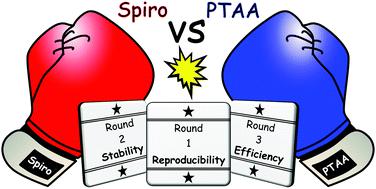当前位置:
X-MOL 学术
›
Energy Environ. Sci.
›
论文详情
Our official English website, www.x-mol.net, welcomes your
feedback! (Note: you will need to create a separate account there.)
Lessons learned from spiro-OMeTAD and PTAA in perovskite solar cells
Energy & Environmental Science ( IF 32.4 ) Pub Date : 2021-08-25 , DOI: 10.1039/d1ee02095a Florine M. Rombach 1 , Saif A. Haque 1 , Thomas J. Macdonald 1
Energy & Environmental Science ( IF 32.4 ) Pub Date : 2021-08-25 , DOI: 10.1039/d1ee02095a Florine M. Rombach 1 , Saif A. Haque 1 , Thomas J. Macdonald 1
Affiliation

|
Organic semiconductors have become essential parts of thin-film electronic devices, particularly as hole transport layers (HTLs) in perovskite solar cells (PSCs) where they represent one of the major bottlenecks to further enhancements in both device stability and efficiency. Small molecule 2,2′,7,7′-tetrakis[N,N-di(4-methoxyphenyl)amino]-9,9′-spirobifluorene (spiro-OMeTAD) and polymer poly[bis(4-phenyl)(2,4,6-trimethylphenyl)amine] (PTAA) are two of the first successful HTLs used in PSCs, and have remained at the forefront of developing high efficiency devices for almost a decade. Since their first application, many investigations into the properties of spiro-OMeTAD and PTAA have contributed to a growing understanding of the mechanisms that enable their success as HTLs. This review summarizes and discusses the key electronic and morphological properties, doping strategies and mechanisms, and degradation pathways of both spiro-OMeTAD and PTAA. A critical comparison between the two materials is provided, highlighting both the similarities which explain their enduring popularity as well as key differences in electrical and morphological properties. From this analysis emerges an improved understanding of the fundamental properties that enable the persistent success of HTL materials, which are found to include not only hole conductivity, band gap, and morphology, but also interactions with dopants, the perovskite, and environmental stressors. The knowledge about these properties, which are critically summarized in this review, is also applicable to the many other types of organic electronic devices now employing spiro-OMeTAD and PTAA. A detailed examination of the properties of materials reveals a clear set of guiding principles for the development of future generation HTLs. Applying these design strategies to produce more advanced HTLs will be essential to further improve the stability, efficiency, and commercialization of PSCs.
中文翻译:

钙钛矿太阳能电池中spiro-OMeTAD和PTAA的经验教训
有机半导体已成为薄膜电子器件的重要组成部分,特别是作为钙钛矿太阳能电池 (PSC) 中的空穴传输层 (HTL),它们是进一步提高器件稳定性和效率的主要瓶颈之一。小分子 2,2',7,7'-tetrakis[ N , N-二(4-甲氧基苯基)氨基]-9,9'-螺二芴(spiro-OMeTAD)和聚合物聚[双(4-苯基)(2,4,6-三甲基苯基)胺](PTAA)是最早的两种成功用于 PSC 的 HTL,并且近十年来一直处于开发高效设备的最前沿。自从首次应用以来,对 spiro-OMeTAD 和 PTAA 的特性进行了许多研究,这有助于加深对使它们成功成为 HTL 的机制的理解。本综述总结并讨论了螺-OMeTAD 和 PTAA 的关键电子和形态学特性、掺杂策略和机制以及降解途径。提供了两种材料之间的重要比较,突出了解释它们经久不衰的相似之处以及电气和形态特性的主要差异。从这项分析中,我们对 HTL 材料持续成功的基本特性有了更好的理解,发现这些特性不仅包括空穴电导率、带隙和形态,还包括与掺杂剂、钙钛矿和环境压力源的相互作用。本综述中批判性地总结了有关这些特性的知识,也适用于现在使用 spiro-OMeTAD 和 PTAA 的许多其他类型的有机电子器件。对材料特性的详细检查揭示了开发下一代 HTL 的一套明确的指导原则。应用这些设计策略来生产更先进的 HTL 对于进一步提高 PSC 的稳定性、效率和商业化至关重要。
更新日期:2021-08-25
中文翻译:

钙钛矿太阳能电池中spiro-OMeTAD和PTAA的经验教训
有机半导体已成为薄膜电子器件的重要组成部分,特别是作为钙钛矿太阳能电池 (PSC) 中的空穴传输层 (HTL),它们是进一步提高器件稳定性和效率的主要瓶颈之一。小分子 2,2',7,7'-tetrakis[ N , N-二(4-甲氧基苯基)氨基]-9,9'-螺二芴(spiro-OMeTAD)和聚合物聚[双(4-苯基)(2,4,6-三甲基苯基)胺](PTAA)是最早的两种成功用于 PSC 的 HTL,并且近十年来一直处于开发高效设备的最前沿。自从首次应用以来,对 spiro-OMeTAD 和 PTAA 的特性进行了许多研究,这有助于加深对使它们成功成为 HTL 的机制的理解。本综述总结并讨论了螺-OMeTAD 和 PTAA 的关键电子和形态学特性、掺杂策略和机制以及降解途径。提供了两种材料之间的重要比较,突出了解释它们经久不衰的相似之处以及电气和形态特性的主要差异。从这项分析中,我们对 HTL 材料持续成功的基本特性有了更好的理解,发现这些特性不仅包括空穴电导率、带隙和形态,还包括与掺杂剂、钙钛矿和环境压力源的相互作用。本综述中批判性地总结了有关这些特性的知识,也适用于现在使用 spiro-OMeTAD 和 PTAA 的许多其他类型的有机电子器件。对材料特性的详细检查揭示了开发下一代 HTL 的一套明确的指导原则。应用这些设计策略来生产更先进的 HTL 对于进一步提高 PSC 的稳定性、效率和商业化至关重要。











































 京公网安备 11010802027423号
京公网安备 11010802027423号